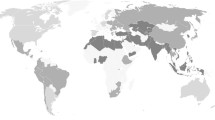Abstract
Allan Kellehear argued that the otherworld society envisioned in near-death experiences (NDEs) is similar to utopian societies. However, his cultural analysis, based on 9 Mormon NDEs, did not reflect the diversity of near-death visions from other cultures. I suggest that these Mormon NDEs were neither as utopian as Kellehear assumed nor representative of contemporary NDE reports, and that a more complete analysis would reveal a variety of NDEs and otherworld visions reflecting the experiencers' sociocultural back-ground. Robert Bellah's model of religious evolution provides a model for charting the NDE's change over time and cultures, and allows us to differentiate the perennial features of the NDE from the transient culturally-determined ones — a first step in understanding the role of NDEs in the quest for an ideal society.
Similar content being viewed by others
References
Bellah, R.N. (1964). Religious evolution.American Sociological Review, 28, 353–374.
Counts, D.A. (1983). Near-death and out-of-body experiences in a Melanesian society.Anabiosis: The Journal of Near-Death Studies, 3, 115–135.
Doctrine and Covenants. (1979). Salt Lake City, UT: Church of Jesus Christ of Latter-Day Saints. (Original work published 1880)
Gallup, G., Jr., and Proctor, W. (1982).Adventures in immortality: A look beyond the threshold of death. New York, NY: McGraw-Hill.
Journal of Discourses. (1966). Los Angeles, CA: General Printing and Lithograph. (Original work published 1882)
Langer, S.K. (1957).Philosophy in a new key: A study in the symbolism of reason, rite and art (3rd ed.). Cambridge, MA: Harvard University Press.
Lundahl, C.R. (1981–82). The perceived other world in Mormon near-death experiences: A social and physical description.Omega, 12, 319–327.
Lundwall, N.B. (n.d.).The vision. Salt. Lake City, UT: Bookcraft.
Moody, R.A., Jr. (1975).Life after life. Covington, GA: Mockingbird Books.
Neihardt, J.G. (1961).Black Elk speaks. Lincoln, NE: University of Nebraska Press.
Niebuhr, R. (1953).The nature and destiny of man. New York, NY: Charles Scribner's Sons.
Osis, K., and Haraldsson, E. (1977).At the hour of death. New York, NY: Avon.
Pasricha, S., and Stevenson, I. (1986). Near-death experiences in India: A preliminary report.Journal of Nervous and Mental Disease, 174, 165–170.
Zaleski, C. (1987).Otherworld journeys: Accounts of near-death experience in medieval and modern times New York, NY: Oxford University Press.
Author information
Authors and Affiliations
Additional information
Howard Mickel, Ph.D., formerly Chairman of the Department of Religion at Wichita State University, is currently Director of the Theta Project, an educational and research effort focusing on near-death and related experiences.
Rights and permissions
About this article
Cite this article
Mickel, H.A. A critique of Kellehear's transcendent society. J Near-Death Stud 10, 123–130 (1991). https://doi.org/10.1007/BF01074044
Issue Date:
DOI: https://doi.org/10.1007/BF01074044




